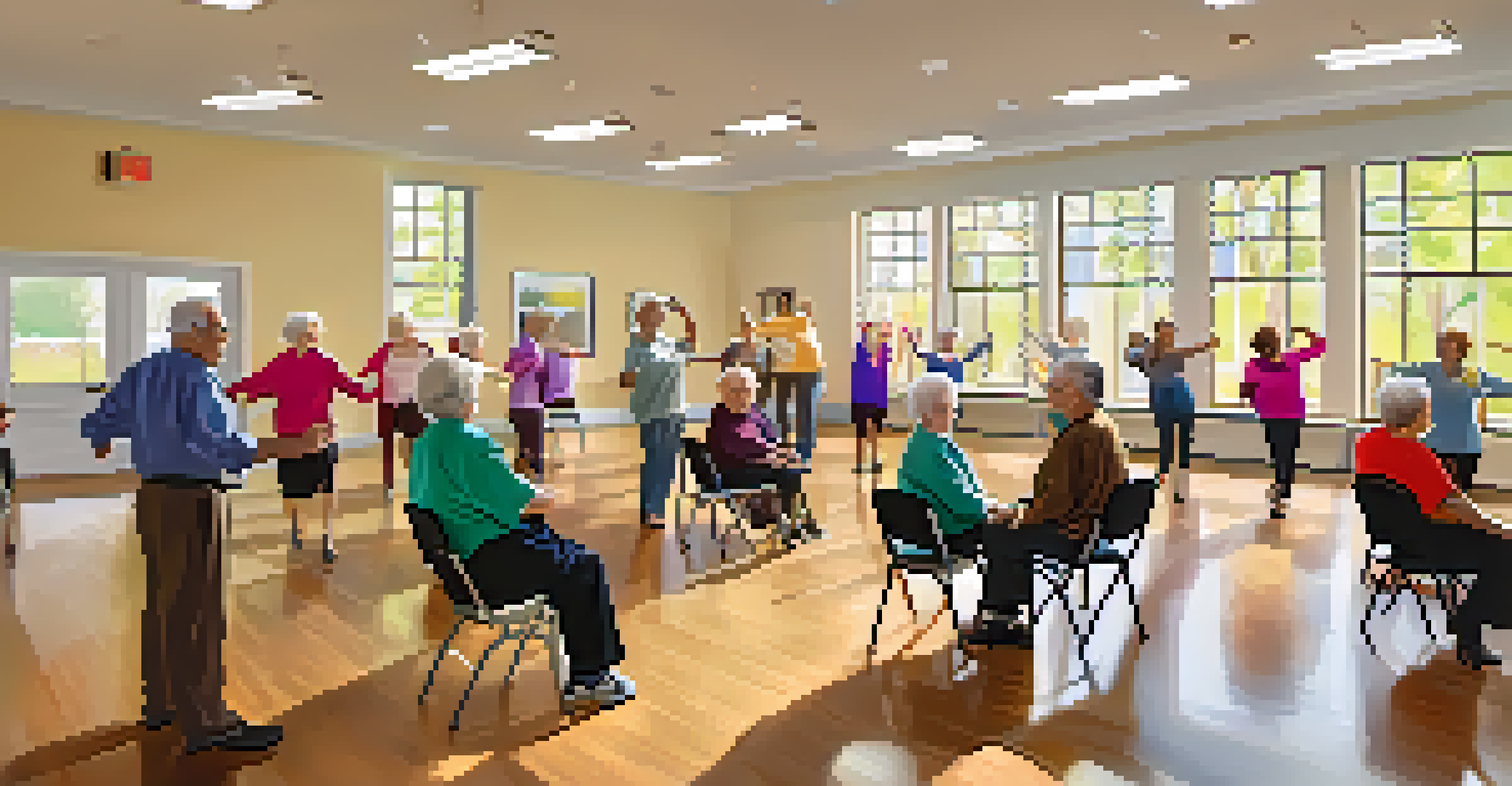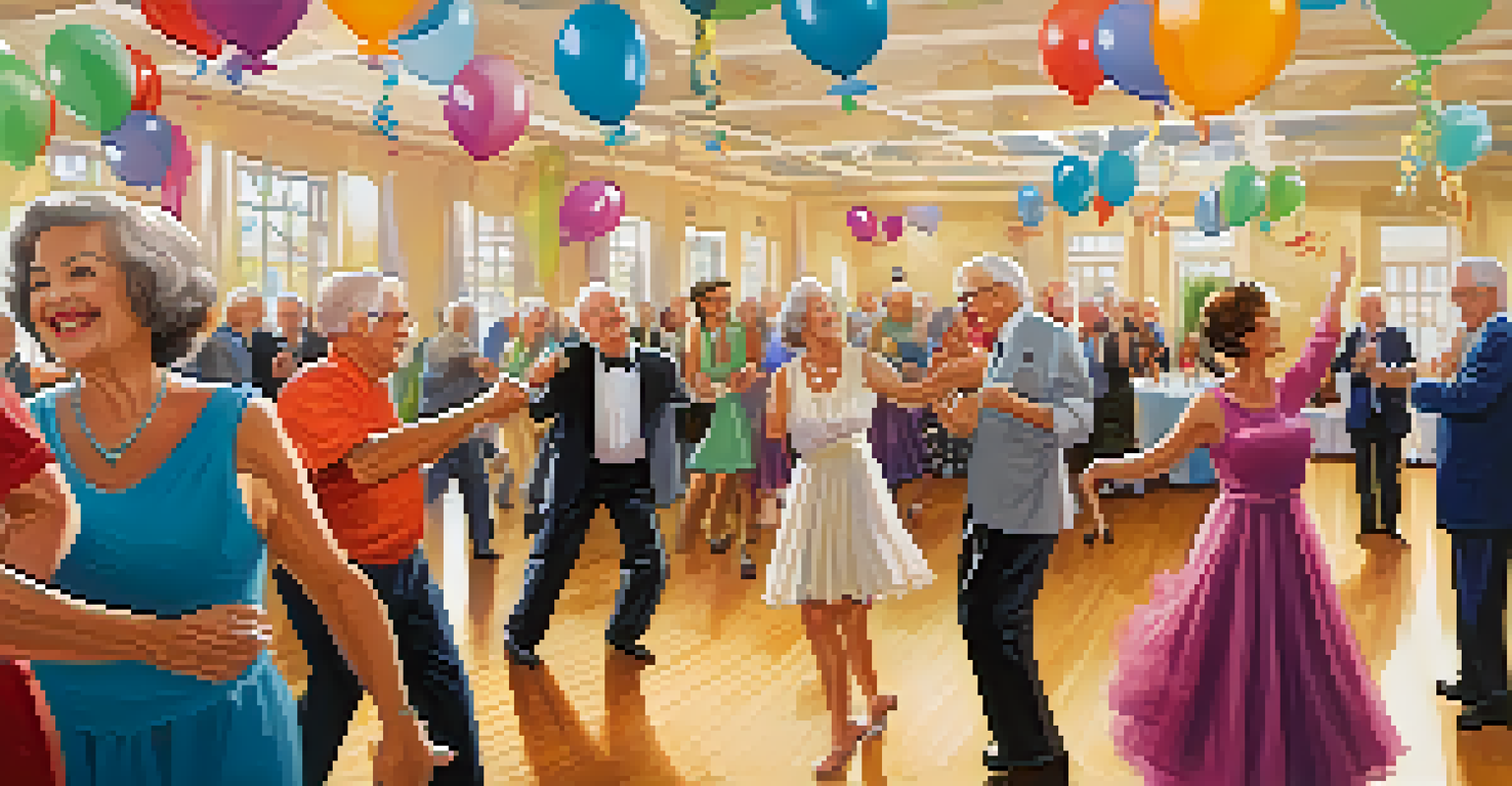Adapting Dance Techniques for Mobility Challenges in Seniors

Understanding Mobility Challenges in Seniors
As we age, our bodies often face various mobility challenges, such as arthritis, balance issues, or reduced flexibility. These conditions can make it difficult for seniors to participate in physical activities, including dance. However, recognizing these challenges is the first step toward finding inclusive solutions that allow seniors to enjoy the benefits of dance.
Dance is the hidden language of the soul.
Mobility issues can vary greatly among seniors, with some individuals experiencing minor limitations while others face significant obstacles. It's essential to approach each person as unique, tailoring adaptations to fit their specific needs and abilities. By adopting a personalized approach, we can help seniors engage with dance in a way that feels comfortable and enjoyable.
Dance is not only a form of exercise but also a way to express emotions and connect with others. Understanding mobility challenges can empower instructors and caregivers to create a supportive environment where seniors can thrive, regardless of their physical limitations.
Benefits of Dance for Seniors with Mobility Issues
Engaging in dance offers numerous benefits for seniors, especially those facing mobility challenges. Dance can improve cardiovascular health, enhance flexibility, and promote better balance, which are critical for maintaining independence. Additionally, the social aspect of dance fosters connections, reducing feelings of isolation often experienced by older adults.

Moreover, dance serves as a joyful form of expression, allowing seniors to connect with their emotions and creativity. This emotional outlet can contribute significantly to mental health, helping to alleviate feelings of depression and anxiety. When seniors feel good emotionally, they are more likely to participate actively in their physical health.
Mobility Challenges in Seniors
Understanding and acknowledging the unique mobility challenges faced by seniors is crucial for creating inclusive dance opportunities.
By adapting dance techniques to accommodate mobility challenges, instructors can ensure that seniors enjoy these benefits without feeling overwhelmed. This approach not only increases participation but also instills confidence, encouraging seniors to explore their physical capabilities further.
Adapting Dance Styles for Limited Mobility
Different dance styles can be modified to suit seniors with mobility limitations. For instance, seated dance allows participants to enjoy rhythm and movement while remaining in a chair, ensuring safety and comfort. Styles like line dancing or simple folk dances can also be adapted to accommodate various levels of mobility.
Movement is a medicine for creating change in a person's physical, emotional, and mental states.
Instructors can introduce gentle movements that focus on upper body coordination, allowing seniors to engage their arms and hands while seated or standing with support. This not only keeps them active but also helps improve their range of motion, which is crucial for maintaining mobility over time.
Incorporating props, such as scarves or lightweight balls, can make these adaptations even more engaging. Props add a playful element to dance, encouraging seniors to express themselves creatively while also enhancing their physical coordination.
Creating a Safe Dance Environment for Seniors
Safety is paramount when adapting dance techniques for seniors with mobility challenges. Instructors should ensure that the dance space is free from obstacles and has a supportive surface to prevent slips and falls. Providing sturdy chairs or handrails can also help seniors feel secure while they dance.
It's important to assess each participant's individual needs before starting a session. This might include a brief discussion about their mobility limitations, any necessary assistive devices, and how comfortable they feel with different movements. By doing so, instructors can tailor their approach and ensure that everyone feels safe and included.
Dance Benefits for Seniors
Engaging in dance can significantly improve seniors' physical health, emotional well-being, and social connections.
Encouraging seniors to wear comfortable clothing and supportive footwear can further enhance their experience. When seniors feel comfortable, they are more likely to participate fully, allowing them to reap the benefits of dance without fear or hesitation.
Incorporating Music and Rhythm for Engagement
Music is a powerful tool in dance, especially for seniors. Choosing upbeat and familiar songs can spark joy and nostalgia, encouraging seniors to connect emotionally with the experience. Music enhances rhythm, making it easier for seniors to follow along with adapted movements.
Instructors can invite seniors to share their favorite songs, creating a personalized playlist that resonates with them. This not only makes the sessions more enjoyable but also encourages a sense of ownership and involvement in the dance process. When participants feel included, their engagement and enthusiasm naturally increase.
Furthermore, incorporating simple rhythmic clapping or tapping exercises can warm up seniors' bodies and minds, making them feel more connected to the music. These activities are a fantastic way to build a sense of community, reinforcing the social benefits of dance.
Encouraging Social Interaction through Dance
Dance can be a social activity that fosters connections among seniors. Group classes provide opportunities for participants to interact, share experiences, and build friendships. Encouraging seniors to dance together can create a supportive atmosphere that enhances their overall wellbeing.
Pairing seniors for partner dances, even if they're seated, encourages collaboration and communication. This not only improves their social skills but also allows them to learn from one another. Such interactions can boost self-esteem and create a sense of belonging within the dance community.
Adapting Dance for Safety
Modifying dance styles and creating a safe environment allows seniors with mobility issues to participate fully and enjoy the experience.
Creating themed dance parties or community events can further promote social interaction. These gatherings allow seniors to showcase their skills, share stories, and celebrate their achievements together, reinforcing the idea that dance is about connection and joy.
Resources for Seniors and Caregivers
Several resources are available for seniors and caregivers interested in adapting dance techniques for mobility challenges. Local community centers often offer specialized dance classes designed for older adults, providing a safe and supportive environment. Online platforms also feature virtual dance classes that seniors can join from the comfort of their homes.
Additionally, organizations focused on elder care and wellness may provide workshops and training sessions for instructors. These educational opportunities can empower caregivers and instructors to better understand the unique needs of seniors, ensuring that they can offer the best support possible.

Lastly, online forums and social media groups dedicated to senior wellness can serve as valuable platforms for sharing experiences and tips. Engaging with these communities can help seniors and caregivers find inspiration, resources, and encouragement as they explore dance together.